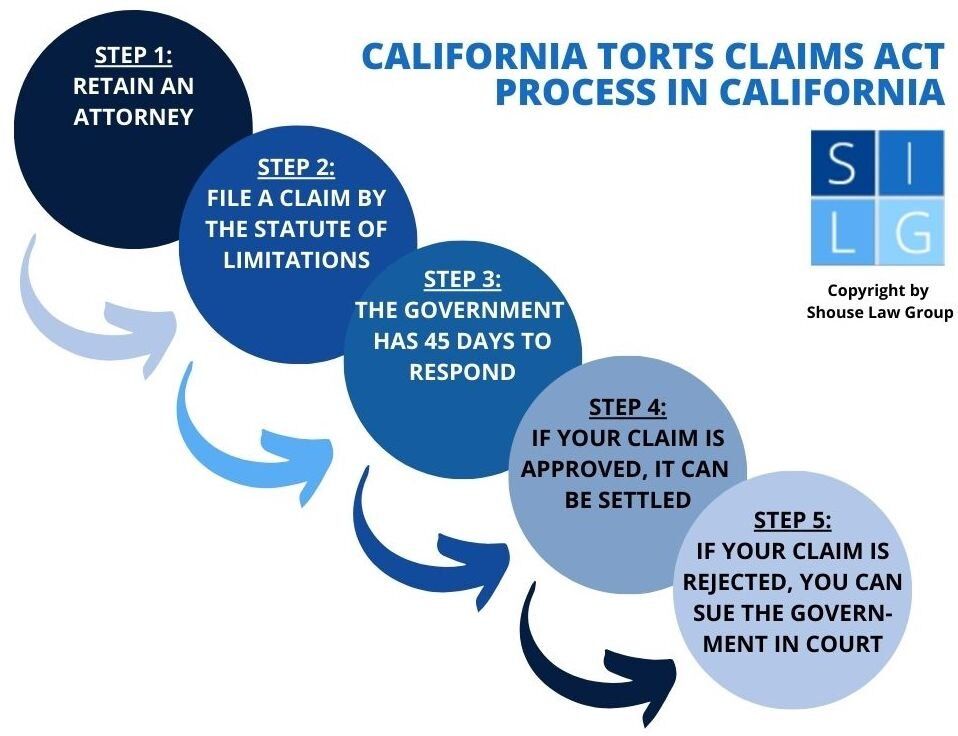California Tort Claims Act – How to Sue The Government
The California Tort Claims Act (CTCA) permits you to sue the state or local government in certain circumstances involving personal injury, property damage or wrongful death. However, the procedures are very strict, and you usually have only six months to start the legal process.
The following flowchart shows the progression of CTCA claims in California:

Below our California personal injury attorneys explain everything you need to know about suing the government under the CTCA.
- What does the California Tort Claims Act do?
- When can I sue the government?
- What are some examples?
- When can I not sue the government?
- How do I sue under the CTCA?
- What is the statute of limitations to file a claim?
- What happens after I file my claim?
- Do I need a lawyer?
- In Sum
- Additional Reading
What does the California Tort Claims Act do?
The CTCA protects the California government and its employees from being sued in most circumstances. This is called “sovereign immunity,” and its purpose is to keep government running without being bombarded with lawsuits all the time. 1
This law extends to all parts of the state government, such as:
- State agencies
- School districts
- State universities (including Regents and Trustees)
- Individual counties and cities
- Special districts (such as water districts and transit authorities)

The California Tort Claims Act protects the state government from legal liability in certain personal injury cases.
When can I sue the government?
The CTCA permits you to sue the California government if you were injured by either:
- The negligence of government employees or independent contractors;
- The government’s failure to perform a legal duty; and/or
- A hazardous condition on government property. 2
Successful claims may result in compensatory damages for your medical bills, loss of income, property damage, and pain & suffering.
What are some examples?
The CTCA would allow you to sue the California government if you were injured in the following scenarios:
- Falling down a pothole: The government was negligent by not maintaining safe roads.
- Falling down courthouse stairs because there were no handrails: The government was liable under premises liability because they failed to fix a known hazard on its property.
- Getting assaulted by an on-duty state welfare worker who was mentally unstable: The government was negligent in hiring or supervising the worker.
When can I not sue the government?
The CTCA generally does not allow claims for any reason except those listed above. For example, you cannot sue the government for injuries caused by:
- The failure to pass a regulation, ordinance, or law;
- The California National Guard;
- The failure to enforce a specific law;
- An issuance or failure to issue any permit, license, certificate, or other governmental authorization;
- The failure to inspect any property which the government itself does not own;
- Any misrepresentation; or
- Reporting identifying information of convicted drug offenders to local schools.
Moreover, punitive damages are generally not allowed in a claim against the government.
How do I sue under the CTCA?
First, you must give notice of your claim. Many agencies and municipalities in California have claim forms that you can fill out to provide notice of the claim.
The claim must include all of the following information:
- Your name and postal office address
- The post office address to which you desire notices to be sent
- The date, place and circumstances of the occurrence which gave rise to your claim
- A general description of your damages
- The name or names of the public employee or employees causing the damages (if known)
If your claim exceeds $10,000, you may not be required to indicate the amount you seek in your claim. However, you are required to indicate whether you are seeking less than $25,000. 3

There are exceptions where you can sue the state government despite the CTCA.
What is the statute of limitation to file a claim?
The CTCA requires you to file a claim within six months of your injury (or discovering your injury) if the case concerns:
- Personal injury,
- Wrongful death,
- Damage to personal property, or
- Damage to crops.
The time limit to bring claims that relate to all other causes is within one year of the injury. Some of these actions would include:
- Breach of contract actions;
- Damage to real property; or
- Declaratory judgment actions not subject to a six-month limitation. 4
What happens after I file my claim?
Once you file your CTCA claim, the public agency generally has 45 days in which to respond or take action.
The government may approve the claim in whole or in part. If so, the entity may offer a compromise to the claim, which may settle the whole case.
If the government rejects your claim, you are free to file suit in state court against the government. 5
Do I need a lawyer?
It is highly advised. Suing the state, city, county or other public entity is a lot more complex and technical than bringing a small claims case. There are very strict deadlines and procedures you have to follow to the letter or else risk having your case dismissed.
Your attorney would:
- Determine that you are eligible to file under the CTCA.
- Compose and file all relevant documents correctly and within the designated statute of limitations.
- Investigate your case and gather and preserve any evidence.
- Settle your case if possible by aggressively negotiating with the government’s attorneys.
- If necessary, take your case to trial in state court.
In Sum
Here are five key things to know about the California Tort Claims Act:
- There are exceptions that allow you to bring an injury claim against the government and seek damages.
- In most cases, you must file proper notice of a claim within six months of the injury or accident.
- The government may be liable in circumstances involving premises liability where it had notice of the dangerous condition.
- The government may also be responsible when it was vicariously liable for the negligence of an employee.
- Successful claims may result in compensatory damages but not punitive damages.

You should retain an attorney to file your claim against the government, which is a very technical process.
Additional Reading
For more in-depth information, refer to these scholarly articles:
- California Tort Claims Act: Discretionary Immunity – Southern California Law Review.
- The Constitutional Infirmity of the California Government Claim Statute – Pepperdine Law Review.
- California Public Entity Immunity from Tort Claims by Prisoners – Hastings Law Journal.
- Notes on the California Tort Claims Act–The Discretionary Immunity Doctrine in California – Hastings Law Journal.
- California Governmental Tort Liability and the Collateral Source Rule – Santa Clara Lawyer.
Legal References
- Legal Information Institute, Sovereign Immunity.
- California Legislative Information. Cal. Gov. Code § 815.2. (“A public entity is liable for injury proximately caused by an act or omission of an employee of the public entity within the scope of his employment if the act or omission would, apart from this section, have given rise to a cause of action against that employee or his personal representative.”). See, for example, Hampton v. County of San Diego(2015)62 Cal. 4th 340; Quigley v. Garden Valley Fire Protection Dist. ( 2019) 7 Cal. 5th 798 . California Government Code section 835 — Liability of Public Entities. California Civil Jury Instructions (CACI) 1100 — Dangerous Condition on Public Property. California Government Code 835.2.
- California Legislative Information. Article 1. General 910-913.2. California Legislative Information. Cal. Gov. Code § 910.
- California Legislative Information. Cal. Gov. Code § 911.2. California Legislative Information. Cal. Gov. Code § 911.4.
- California Legislative Information. Cal. Gov. Code § 946.6. California Legislative Information. Cal. Gov. Code § 946.6(f).





